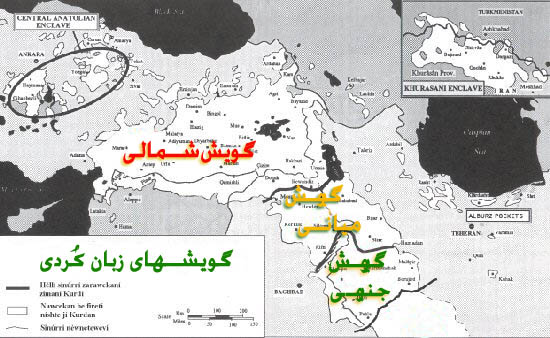Does KAL realise that J. Bedir Khan’s Latin based alphabet also fall in the frame of ISO-Latin?
Does KAL realise that J. Bedir Khan’s Latin based alphabet also fall in the frame of ISO-Latin?
Does KAL realise that J. Bedir Khan’s Latin based alphabet also fall in the frame of ISO-Latin?
Throughout the Kurdish history, the independent scholars and groups have played a seminal role in directing the nation in the struggle for political and/or cultural rights. Their impact, in fact, has been crucial in the turbulent history of the Kurdish nation. Among the most significant of these was the movement to standardize Kurdish language and alphabet in the 1920’s.
In respond to cultural depredations implemented against the Kurdish heritage and language by the occupying forces of land the Kurdish national movement urgently needed a common, administrative Kurdish language. This was crucial to the success of the Kurdish demand as a nation for self determination.
In the past eighty five years we have been content to follow their footsteps. We have seldom, however, looked back to see how this task was implemented by them. Little research was done to critically analyse their achievement and complete their work, although these pioneers themselves admitted that their work done in haste needed further development based on future needs. These included Prince Jeladat Bedir Khan (Mír Jeladet Bedir Xan). He states:
“We have now an achievement an alphabet and a magazine. For me the most appropriate task at present (1932) would be to promote this alphabet. This is until such time when circumstances shall leave us no choice but to modify it. ” (see full Kurdish text)
The J. Bedir Xan’s Latin based alphabet, which is widely used among littered North Kurdish (Kurmanji) speakers, does not fall into the basic and largest ISO-Latin which is ISO-8859-1. It is obvious that J. Bedir Khan followed a fundamental rule for the development of his alphabet, namely by devising a Kurdish alphabet to remain as close as possible to the recently-developed Turkish alphabet of the late 1920s. He used the same structure used by the Turkish (similarly to Arabic Abjad alphabet which only consonant phonemes are represented) to represent one letter for each encoded phoneme based on his North Kurdish sub dialect of Botaní. Therefore he avoided any digraphs. For example, in regards to adopting a phoneme for the sound of “sheen” in Kurdish, Jeladet Bedir Xan explains in his series of articles, “Elfabêya kurdî & Bingehên gramera kurdmancî, Hawar 1932-1943” that:
“The letter for this sound is written with “ch” in French, “sch” in German and “sh” in English. There is no single letters in Latin to adopt for this phoneme. In conformity to our preset rules we have decided to not use any combined letters. The first fundamental rule was to adopt an alphabet system close to the Turkish one.“
He justified his choice by arguing that keeping the Kurdish alphabet close to the Turkish state writing system could facilitate the task for the Kurdish students to be able to read Kurdish as well. He was not alone in promoting this idea, since the Kurdish pioneers in British mandate of Iraq were promoting the use of a Kurdish alphabet as close as possible to Arabic. These were happening in the early 1930s when alphabet standardisations for the use by the electronic media did not exist. Today the phenomenal expansion of information and education in the cyberspace and the availability of diverse sources of information on the Internet have raised new technical concerns on the format and use of communication tools.
KAL has been pioneering the scripting reform in Kurdish to match the modern developments and needs. As such, it has at times raised the question regarding regulation and standardisation of Kurdish writing systems in the belief that a reform at this electronic transitional stage is of great utility. KAL advice that Kurdish scholars should not try to remain orthodox to codification set forth by J. Bedir Khan’s Latin based alphabet vis a vis the ISO-Latin. These standards (ISO-Latin) have myriads of subsections with the J. Bedir Khan’s alphabet crossing between three of them and not follow a single set of standard (see The ISO 8859 Alphabet Soup). It is almost certain that if J. Bedir Khan were alive to see the changes to the communication and Information Technology, he himself would have promoted the reform. J. Bedir Khan began the creation of his alphabet in the late 1920s when he went to exile. He left the newly-created state of Turkey to continue with his political activities to secure the Kurdish basic rights. Turkey, meanwhile, had already declared its new education plan complete with a Latin-based alphabet system (today known as Turkish standard of ISO-8859-9 or Latin 5). We should use these valuable early efforts and complete their task by promoting an unlimited unified writing system for Kurdish.
KAL has based its reform on a single basic standard, namely the ISO-8859-1 framework. However the ISO-889-1 like many of it successors will be replaced by a more multi task and multilingual framework of Unicode. The Unicode has the explicit aim of transcending the limitations of traditional character encodings, such as those defined by the ISO 8859 standard. The first 256 code points of Unicode are made identical to the content of ISO 8859-1 so as to make it trivial to convert existing based on Latin-1 where the Kurdish Unified placed. Unicode takes the role of providing a unique number called code point which produced by computer’s predefined keyboards/Keypad and language writing systems settings. A keyboard/keypad device is the device most commonly used for writing via computer or mobile phones as well as any data entry devices. Each key is associated with a standard code which the keyboard sends to the computer when it is pressed. Different ISO/IEC standards are defined to deal with each individual writing systems to implement them in computers. Currently the Kurdish writing systems Latin (Hawar devised) or Perso-Arabic based are not represented with any international recognised standard keyboards. Many users are forced to install specially designed keyboards on their systems to enable them for writing in Kurdish.
The carefully selected alphabet for Kurdish Unified Writing System is supporting a simple neutral keyboard set which allows users to write Kurdish anywhere by any keyboard with no engineering effort. KAL’s Kurdish Unified Alphabet is based solely on Kurdish language functions and not those from west European or Kurdistan’s neighbouring countries. KAL has truly considered the characteristics of the Kurdish language as one single language and believes that a Unified Kurdish Alphabet based on wider cross dialect workability is the Ultimate choice for Kurdish Language.



